Monday 6th December 1999
By sunrise on Monday the remaining four had become a remaining three, as Anton had had to head home. Straight from the nightclubs to the airport and back to Rome for a full day's work: how hardy is that man!
| Michelle, Eryl and Martin surfaced around ten for a day of
GaudÝ-spotting. We got to the hostel's reception to find a message from Eva saying that
Clare's fins had been found, and were waiting for us at the first pool. Hurrah! Just because we were on holiday didn't mean that Monday morning stopped being Monday morning, so our first stop was a breakfast bar just around the corner from the hostel for a spot of much-needed coffee (much-needed by Eryl, anyway!), orange juice and ham and cheese croissants. Yummy! |
|

Coffee and croissants
|
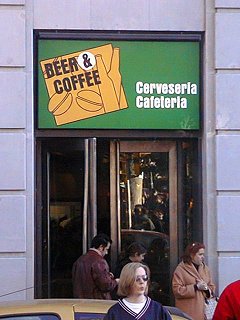
|
|
We then walked up La Ramblas to Placa Catalunya, one of the city's major squares, where we
raided the electronics department of El Corte Ingles, the city's largest department store,
for batteries and storage cards for Martin's digital camera.
Beyond Placa Catalunya we
found ourselves in the Avenida de Gracia, which is noted for its variety of fantastic
architecture, all of which seemed to be vying with each other for the visitor's attention.
However, just as impressive as the various icons of Modernisme was the basic simplicity
of a cafe that seemed to have covered all of life's fundamental requirements . . . |
|
What more could anyone want? |
In the Avenida de Gracia
Gracia Pic 1 |
Gracia Pic 2 |
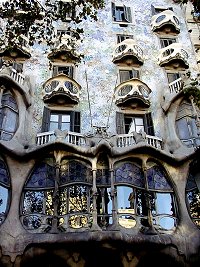
The Casa Batllˇ
|
|
We continued heading north until we hit the Casa Batllˇ, the first of the two famous
GaudÝ buildings in the Avenida de Gracia. GaudÝ once said that straight lines do not
occur in nature, so he was not going to put any in his buildings, and Casa Batllˇ is
certainly indicative of this policy.The more closely we looked at the fašade of the
Casa Batllˇ, the more organic it appeared, and the combination of the eyes in the upper
balconies and the skeletal structure of the lower windows gave the building an altogether
quite menacing feel. Definitely a horror film director's dream!
Like most of Gaudí's creations, the Casa Batlló had been designed and built for a private sponsor, and the building was still very much lived in, although it was obvious that it was now a number of individual flats. We did find ourselves wondering how many Central African republics' Gross National Products it would take to pay the rent on one of these flats! |
A few hundred yards further on, on the other side of the road we found the Casa MilÓ,
probably GaudÝ's most famous work after the Sagrada FamÝlia. Casa MilÓ is also known as
"La Pedrera" ("The Quarry") and from the first glimpse of its rippling
stonework fašade it is easy to see why. Although not as immediately striking as the Casa
Batllˇ, Casa MilÓ impresses more and more the more one sees of it.Casa MilÓ was
built by GaudÝ for the MilÓ family, and floors 1, 2 and 3 of this five-storey building
are still privately occupied, though whether or not still by the MilÓ family we were not
sure. Consequently, our tour started on the fourth floor with "The Apartment".
We elected to climb the stairs rather than taking the lift, and were rewarded with an
excellent view of the remarkable double-helix design on which the Casa MilÓ had been
built. |
|
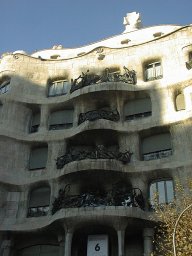
The Casa MilÓ: "La Pedrata"
|
The first part of "The Apartment" floor was an exhibition detailing the rise
of Barcelona as an industrial centre in the early years of the 20th Century and how the
new technologies of gas, electricity and the telephone were embraced and harnessed to make
a better standard of living for the city and for its inhabitants. There was also an
eight-minute film running constantly in a separate darkened room which used all original
film footage to give a fascinating insight into life in Barcelona in this period..
The apartment itself was nothing particularly special, but our expectations were more
than met when we made our way up to the fifth floor. We were now effectively in the attic,
under the roof, and GaudÝ had not passed up on the opportunity to make the practicality
of making the roof stay up into a visual feast for the observer. The attic ran all the way
around the perimeter of the building and was criss-crossed with a series of intricate
brickwork arches that looked more like the spines of dinosaurs than roof supports.
However, if anything, it was the contents of the attic that was the real prize.
The first room housed a series of what looked like orator's tribunes, each of which
housed a lightbox running a series of slides about each of GaudÝ's works - one on Parc
GŘell, one on the Casa Batllˇ, one on the Casa MilÓ and so on. We just marvelled at the
breadth of the man's imagination, and spent a lot of time being wowed by these images. It also served as an excellent way of allowing the visitor to Barcelona to separate the Gaudí works they particularly wanted to see, from those which did not particularly grab them.
In the corner of the building that joined this room to the next was a running film that
detailed the major world events happening during each year of GaudÝ's life - the
assassination of Abraham Lincoln, Bismarck becoming Chancellor of Germany, the outbreak of
what would later be known as the First World War, and so on. The detail into which the
film went meant that it took several minutes to get from one year to the next, but it was
nonetheless fascinating.
Moving into the next room we were presented with a computerised film which ran through
each of GaudÝ's works, explaining the design and construction techniques used in each
one. This was really eye-opening stuff, even to the non-architect, as GaudÝ pioneered a
number of techniques that are now integral to architechtural principles, but had never
previously been thought of.
A glass case in the next room held the finest example of GaudÝ's redical thinking: the
revolutionary upside-down model of the Sagrada FamÝlia that allowed him to calculate -
far more accurately than had ever been done before - the stresses and strains that would
be generated by such a unique construction, and therefore what would need to be done in
order to accommodate them.
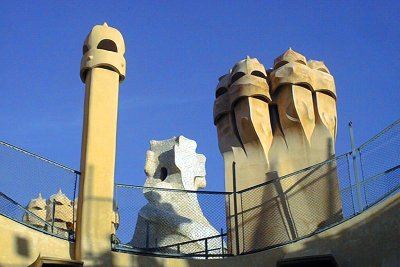 |
|
This room led to the next, and to the next, and finally, before getting to the stairway
to the rooftop, the shop. Dashed cunning . . .
The rooftop was a mass of sweeping steps, air vents and macabre-looking chimney stacks
that made one feel one was either looking over a lunar landscape or trapped inside an
Escher drawing. Martin was snapping away quite happily when a mini-disaster struck: out of
batteries!
|
|
The Casa MilÓ's remarkable chimneys |
A spare set purchased that morning proved to be defective, and as the sun was setting
rapidly, it was essential to source new batteries as quickly as possible. The shop on the
apartment floor didn't sell them, so it was a dash down five flights of stairs and into
the streets in search of an electrical shop or newsagent. Running north up the Avenida de
Gracia: nothing; running south down the Avenida de Gracia: still nothing. Eventually, a
small shopping arcade was spotted in a side street and a tobacconist that sold batteries
was found. Back up the Avenida de Gracia, back up the five flights of stairs . . .
|
By then it was nearly dark, and we suddenly realized that we had all been so engrossed in the GaudÝ museum and the various displays that we had
all failed to realize that we had not eaten anything since breakfast. However, as soon as
we did stop to realize, hunger really set in!
Fortunately, the Casa MilÓ had been set up to provide everything (everything, that is,
except batteries!) and we found a small cafe on the ground floor, where we stopped for a
coffee (beer in some cases) and a snack. However, we relaxed rather more effectively than
we had intended to, and it was suddenly 7pm - an hour before the Casa MilÓ was to close -
and we had not yet made use of the second part of our ticket.
|
|
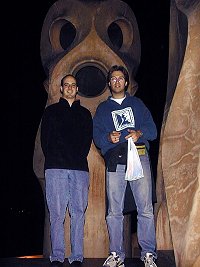 |
|
Beeehiiiind yooouuuu! |
This second part was an art gallery housed on the first floor of the other part of the Casa Milà, and there we found works by a number of famous artists, such as Gaugin, Monet and Kandinsky.
8pm came and we were thrown out of the art gallery. We headed back to the hostel where we
found another message from Eva, saying that she was having a pizza with some friends at
the Pizzaria Veronique just up the road from our hostel and would we like to join her?
This message had been left about two hours before, so we dropped everything and went
straight out again, thinking that we might already have missed her. Fortunately, they were
still there, although if we had arrived any more than ten minutes later, we would have
missed them.
Despite the snack at the Casa MilÓ, we were more than ready to sink some pizza, so we
ate pizza and drank red wine while Eva and her friends topped up their nicotine levels.
Michelle then went back to the hostel for an early night, while Eva and one of her friends
- English, but a Spanish language student - took Eryl and Martin out to one of their
favourite bars. The beer was good, and trying to make ourselves heard above the music gave
us plenty of practice for possible future careers in public speaking.
Around midnight, Eva and her friend said goodnight, but for Eryl and Martin the night
was still very, very young. We capitalised on Eryl's recently-acquired knowledge of the
city's bars and clubs to trace a similar series of steps to those followed the previous
night, although this time without the attempted mugging.
We started off in a bar that boasted a wide range of imported bottled beers - we tried
a good many of them! - before heading on to a nightclub and dancing away the next few
hours. On leaving the club Eryl realized that we were in the same spot where the previous
night the two men had tried to mug him and Anton, and started getting angry all over again. However,
he did calm down again after a while.
We then wandered out to the waterfront and each step of the way brought back to Eryl
memories of the previous night's escapades. However, by the time we got to the seafront
complex everything was shutting down, so after wandering around the various levels for a
bit, we headed for "home". Bedtime: 6am.





